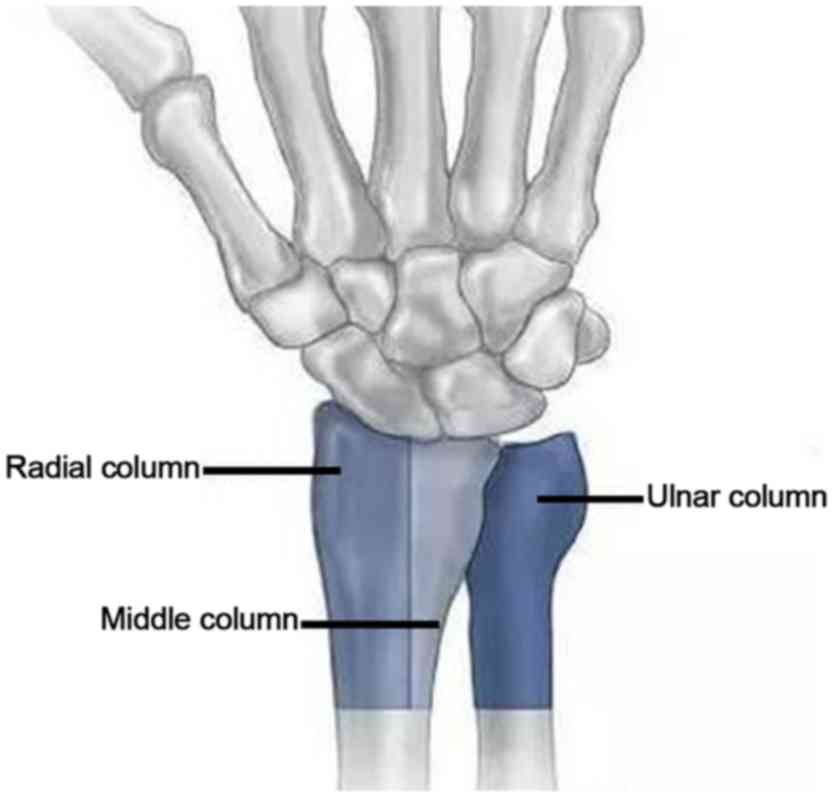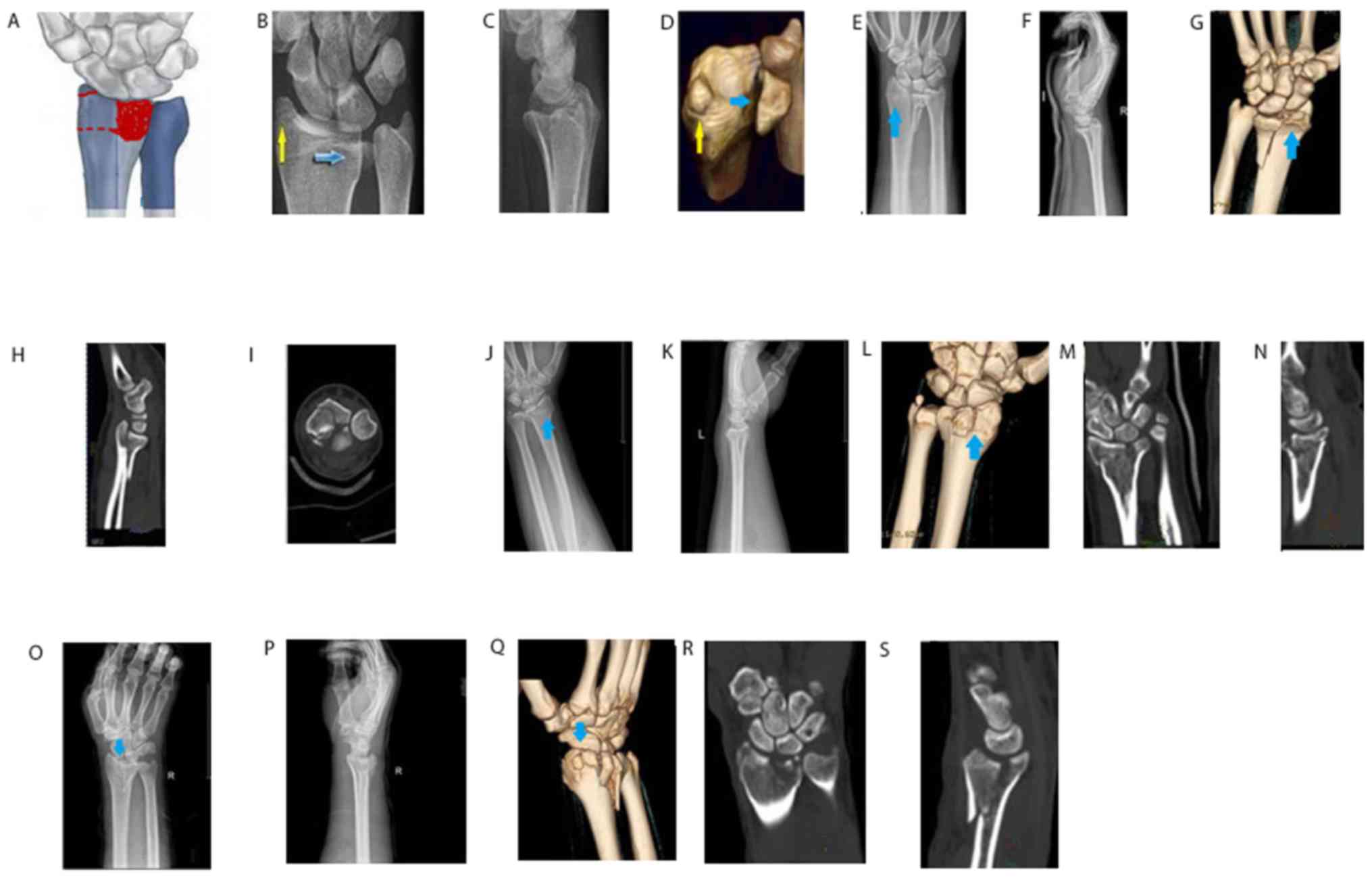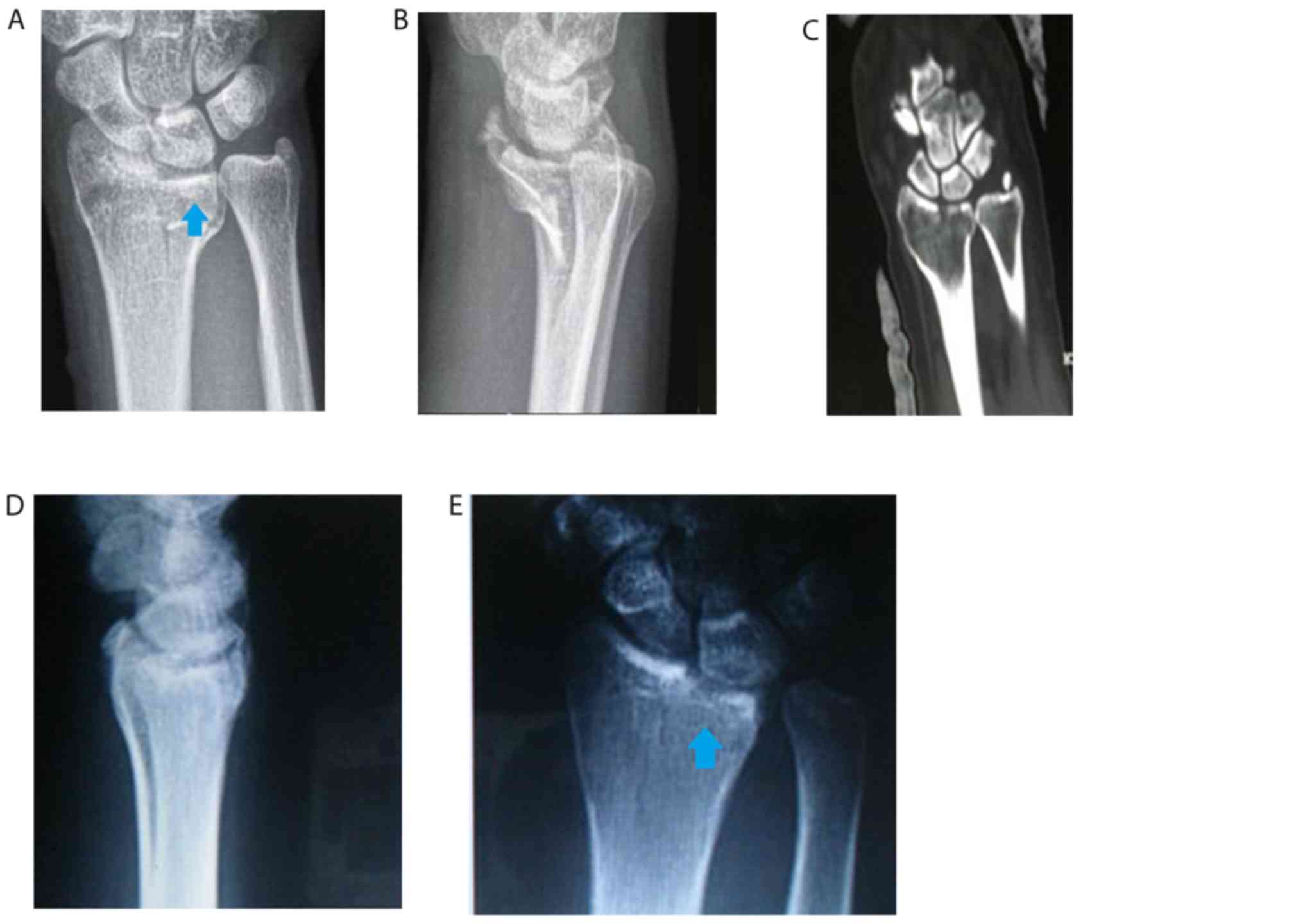|
1
|
Scheck M: Long-term follow-up of treatment
of comminuted fractures of the distal end of the radius by
transfixation with Kirschner wires and cast. J Bone Joint Surg Am.
44-A:337–351. 1962. View Article : Google Scholar : PubMed/NCBI
|
|
2
|
Ma Y, Yin Q, Rui Y, Gu S and Yang Y: Image
classification for Die-punch fracture of intermediate column of the
distal radius. Radiol Med. 122:928–933. 2017. View Article : Google Scholar : PubMed/NCBI
|
|
3
|
Zhang J, Ji XR, Peng Y, Li JT, Zhang LH
and Tang PF: New classification of lunate fossa fractures of the
distal radius. J Orthop Surg Res. 11:1242016. View Article : Google Scholar : PubMed/NCBI
|
|
4
|
Falcochio DF, Crepaldi BE, Trindade CA, da
Costa AC and Chakkour I: What is the best radiographic view for
‘Die Punch’ distal radius fractures? a cadaver model study. Rev
Bras Ortop. 47:27–30. 2015. View Article : Google Scholar : PubMed/NCBI
|
|
5
|
Sun YQ, Stephen M and Meinhard BP:
Surgical treatment of comminuted die-punch patellar fracture.
Orthopedics. 24:947–950. 2001.PubMed/NCBI
|
|
6
|
Zhang X, Hu C, Yu K, Bai J, Tian D, Xu Y
and Zhang B: Volar locking plate (VLP) versus non-locking plate
(NLP) in the treatment of die-punch fractures of the distal radius,
an observational study. Int J Surg. 34:142–147. 2016. View Article : Google Scholar : PubMed/NCBI
|
|
7
|
Rikli DA and Regazzoni P: Fractures of the
distal end of the radius treated by internal fixation and early
function. A preliminary report of 20 cases. J Bone Joint Surg Br.
78:588–592. 1996. View Article : Google Scholar : PubMed/NCBI
|
|
8
|
Inagaki K and Kawasaki K: Distal radius
fractures-Design of locking mechanism in plate system and recent
surgical procedures. J Orthop Sci. 21:258–262. 2016. View Article : Google Scholar : PubMed/NCBI
|
|
9
|
Lucas GL and Sachtjen KM: An analysis of
hand function in patients with colles' fracture treated by Rush rod
fixation. Clin Orthop Relat Res. 172–179. 1981.PubMed/NCBI
|
|
10
|
Almedghio S, Arshad MS, Almari F and
Chakrabarti I: Effects of ulnar styloid fractures on unstable
distal radius fracture outcomes: A systematic review of comparative
studies. J Wrist Surg. 7:172–181. 2018. View Article : Google Scholar : PubMed/NCBI
|
|
11
|
Anderson DD, Deshpande BR, Daniel TE and
Baratz ME: A three-dimensional finite element model of the
radiocarpal joint: Distal radius fracture step-off and stress
transfer. Iowa Orthop J. 25:108–117. 2005.PubMed/NCBI
|
|
12
|
Dwyer CL, Crosby NE, Cooney T, Seeds W and
Lubahn JD: Treating unstable distal radius fractures with a
nonspanning external fixation device: Comparison with volar locking
plates in historical control group. Am J Orthop (Belle Mead NJ).
46:E344–E352. 2017.PubMed/NCBI
|
|
13
|
Jose A, Suranigi SM, Deniese PN, Babu AT,
Rengasamy K and Najimudeen S: Unstable distal radius fractures
treated by volar locking anatomical plates. J Clin Diagn Res.
11:RC04–RC08. 2017.PubMed/NCBI
|
|
14
|
Peng F, Liu YX and Wan ZY: Percutaneous
pinning versus volar locking plate internal fixation for unstable
distal radius fractures: A meta-analysis. J Hand Surg Eur Vol.
43:158–167. 2018. View Article : Google Scholar : PubMed/NCBI
|
|
15
|
Melone CP Jr: Distal radius fractures:
Patterns of articular fragmentation. Orthop Clin North Am.
24:239–253. 1993.PubMed/NCBI
|
|
16
|
Fernandez DL: Fractures of the distal
radius: Operative treatment. Instr Course Lect. 42:73–88.
1993.PubMed/NCBI
|
|
17
|
Burnier M, Herzberg G and Izem Y:
Patient-accident-fracture (PAF) classification of distal radius
fractures. Hand Surg Rehabil. 35S:S34–S38. 2016.(In French).
View Article : Google Scholar : PubMed/NCBI
|
|
18
|
Chia B, Kozin SH, Herman MJ, Safier S and
Abzug JM: Complications of pediatric distal radius and forearm
fractures. Instr Course Lect. 64:499–507. 2015.PubMed/NCBI
|
|
19
|
Mathews AL and Chung KC: Management of
complications of distal radius fractures. Hand Clin. 31:205–215.
2015. View Article : Google Scholar : PubMed/NCBI
|
|
20
|
Mulders MA, Rikli D, Goslings JC and Schep
NW: Classification and treatment of distal radius fractures: A
survey among orthopaedic trauma surgeons and residents. Eur J
Trauma Emerg Surg. 43:239–248. 2017. View Article : Google Scholar : PubMed/NCBI
|
|
21
|
Qiu WJ, Li YF, Ji YH, Xu W, Zhu XD, Tang
XZ, Zhao HL, Wang GB, Jia YQ, Zhu SC, et al: The comparative risk
of developing postoperative complications in patients with distal
radius fractures following different treatment modalities. Sci Rep.
5:153182015. View Article : Google Scholar : PubMed/NCBI
|
|
22
|
Yamamoto K, Masaoka T, Shishido T and
Imakiire A: Clinical results of external fixation for unstable
Colles' fractures. Hand Surg. 8:193–200. 2003. View Article : Google Scholar : PubMed/NCBI
|
|
23
|
Kamphaus A, Rapp M, Wessel LM, Buchholz M,
Massalme E, Schneidmuller D, Roeder C and Kaiser MM: LiLa
classification for paediatric long bone fractures. Intraobserver
and interobserver reliability. Unfallchirurg. 118:326–335. 2015.(In
German). View Article : Google Scholar : PubMed/NCBI
|
|
24
|
Randsborg PH and Sivertsen EA:
Classification of distal radius fractures in children: Good inter-
and intraobserver reliability, which improves with clinical
experience. BMC Musculoskelet Disord. 13:62012. View Article : Google Scholar : PubMed/NCBI
|
|
25
|
Sonderegger J, Schindele S, Rau M and
Gruenert JG: Palmar multidirectional fixed-angle plate fixation in
distal radius fractures: Do intraarticular fractures have a worse
outcome than extraarticular fractures? Arch Orthop Trauma Surg.
130:1263–1268. 2010. View Article : Google Scholar : PubMed/NCBI
|
|
26
|
Bartl C, Stengel D, Bruckner T and Gebhard
F; ORCHID Study Group, : The treatment of displaced intra-articular
distal radius fractures in elderly patients. Dtsch Arztebl Int.
111:779–787. 2014.PubMed/NCBI
|
|
27
|
Chen C, Cai L, Zhang C, Wang J, Guo X and
Zhou Y: Treatment of die-punch fractures with 3D printing
technology. J Invest Surg. 31:385–392. 2018. View Article : Google Scholar : PubMed/NCBI
|



















